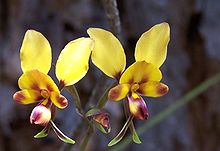Diuris carinata
| Tall Bee Orchid | |
|---|---|
 |
|
| Diuris carinata | |
| Scientific classification | |
| Kingdom: | Plantae |
| (unranked): | Angiosperms |
| (unranked): | Monocots |
| Order: | Asparagales |
| Family: | Orchidaceae |
| Subfamily: | Orchidoideae |
| Tribe: | Diurideae |
| Subtribe: | Diuridinae |
| Genus: | Diuris |
| Species: | D. carinata |
| Binomial name | |
|
Diuris carinata Lindl. |
|
Diuris carinata is a species of orchid, commonly known as the tall bee orchid although members of this genus are generally known as donkey orchids because of the large, ear-like lateral petals. It is endemic to the south-west of Western Australia.
Diuris carinata is a tuberous, perennial herb with four or five leaves and a flower stem about 30 cm (1 foot) high. Flowers appear from October to November and are yellow with a purple spot at the base and apex of the dorsal sepal and petals. Each flower is about 19 mm (3⁄4 in) wide and 25 mm (0.98 in) long.
The species was first described by John Lindley in his 1840 book The Genera and Species of Orchidaceous Plants from a specimen collected by James Drummond near the Swan River. Its specific epithet (carinata) is derived from the Latin carinatus "keel" referring to the keel-like structure of parts of the flower.
The species is endemic to the south western corner of Western Australia, occurring in the Jarrah Forest and Swan Coastal Plain biogeographical regions of Western Australia. It grows in sandy clay in winter-wet swamps.
...
Wikipedia
